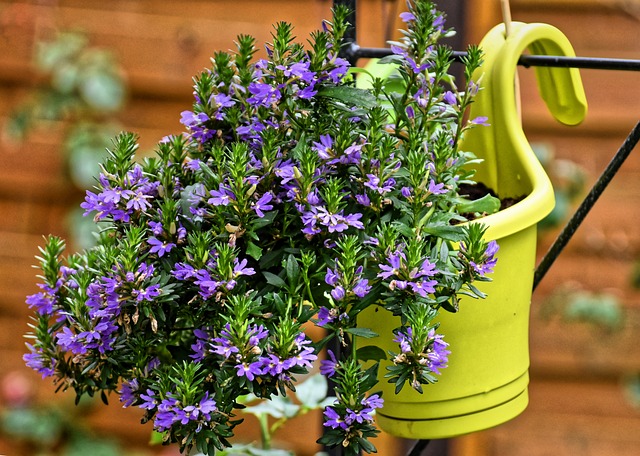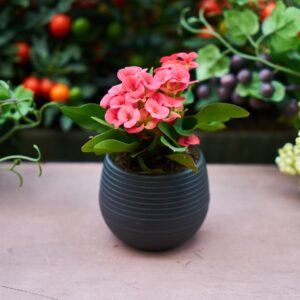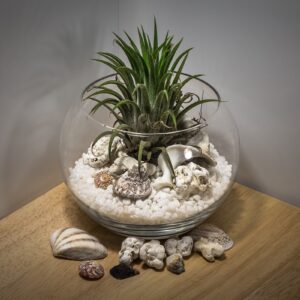Do you love having houseplants in your home? They can brighten up any room and provide many benefits, such as improving air quality and reducing stress. However, keeping them healthy can be a challenge, especially when it comes to avoiding common plant diseases.
But fear not, with a little knowledge and some preventative measures, you can keep your houseplants thriving for years to come.
In this article, we will explore the most common houseplant diseases and how to identify them. We will delve into the causes of these diseases and how to prevent them from spreading. Additionally, we will provide tips on how to treat infected plants and maintain healthy ones.
With this information, you can become a plant health expert and enjoy the beauty and benefits of houseplants in your home. So, let’s dive in and learn how to preserve houseplant health by avoiding common plant diseases.
Identifying Common Houseplant Diseases
If you’re looking to keep your leafy friends from suffering, it’s important to be able to spot and address any potential issues they may be facing. Identifying common houseplant diseases is the first step in preserving their health.
One of the most common diseases is powdery mildew, which appears as a white, powdery substance on leaves. Preventative measures include providing adequate air circulation and avoiding overwatering. Effective treatments include removing infected leaves and applying a fungicide.
Another common disease is root rot, which is caused by overwatering and poorly-draining soil. Symptoms include yellowing leaves and a foul odor. Preventative measures include ensuring proper drainage and allowing the soil to dry out between waterings. Effective treatments include repotting the plant with fresh soil and trimming away any affected roots.
By being observant and taking action at the first sign of disease, you can help ensure your houseplants stay healthy and happy.
Understanding the Causes of Plant Diseases
To keep your green friends happy, you need to know what makes them sick – after all, “an ounce of prevention is worth a pound of cure.” Preventing plant diseases starts with understanding their causes.
One of the most important factors is soil quality. Poor soil quality can lead to a host of problems, including root rot, fungal infections, and nutrient deficiencies. Make sure your plants are potted in well-draining soil that’s rich in nutrients. You can also add organic matter, such as compost or worm castings, to improve soil quality.
Another common cause of plant diseases is overwatering. When plants are watered too frequently or too much, their roots can become waterlogged, which can lead to root rot and other fungal infections. To avoid this, make sure you’re watering your plants correctly. Check the soil moisture level before watering and only water when the top inch of soil is dry. Also, make sure your pots have drainage holes to allow excess water to escape.
By paying attention to soil quality and watering habits, you can help prevent many common plant diseases and keep your houseplants healthy and thriving.
Preventing the Spread of Disease
Make sure you’re taking all the necessary precautions to keep your green friends healthy, including preventing the spread of any potential diseases. Cleaning practices are essential to keeping your plants healthy. Make sure to clean any tools, such as pruning shears or scissors, before using them on a different plant. You can do this by wiping them down with rubbing alcohol or a diluted bleach solution.
Additionally, make sure to clean the soil and any debris that may have fallen onto the leaves or pot. This will prevent any bacteria or fungi from spreading to other plants.
Another important technique for preventing the spread of disease is quarantine. If you notice any signs of disease, such as yellowing leaves or spots, isolate the plant immediately. This will prevent any potential spread to other plants in your collection. Keep the infected plant away from any healthy plants and monitor it closely. You may need to dispose of the plant if the disease is too severe and cannot be treated.
By implementing these cleaning practices and quarantine techniques, you can help keep your plant collection healthy and thriving.
Treating Infected Plants
Oh no, your precious green friends have been infected! Don’t panic, you’ll learn how to nurse them back to health in no time.
The first step is to identify the type of disease that’s affecting your plant. This can be done by observing the symptoms, such as discoloration, wilting, and mold growth. Once you’ve identified the problem, you can take the necessary steps to treat it.
One option is to use natural remedies, such as neem oil or a mixture of water and baking soda. These can be applied directly to the affected areas of the plant and can help to kill off the disease-causing organisms.
However, if the infection is severe or has spread throughout the plant, you may need to seek professional help. A plant specialist or horticulturist can provide expert advice on how to treat the disease and prevent it from spreading to other plants in your home.
With the right care and attention, your infected plants can be nursed back to health and continue to thrive in your home.
Maintaining Healthy Houseplants
Looking after your leafy companions is crucial to ensure they stay happy and thriving in your home.
One of the most important factors in maintaining healthy houseplants is choosing the proper lighting. Different plants require different levels of light, so it’s important to do your research and place them in the right spot. For example, plants that require high levels of light should be placed near windows that receive direct sunlight, while plants that require low levels of light should be placed in rooms with less natural light or in shaded areas.
Watering techniques are also key in keeping your houseplants healthy. It’s important to not overwater or underwater your plants, as both can lead to root rot and other issues. A good rule of thumb is to let the top inch of soil dry out before watering again.
Additionally, make sure to use room temperature water and avoid getting water on the leaves of your plants, as this can lead to fungal growth.
By following these simple tips, you can help ensure your houseplants stay healthy and vibrant for years to come.
Frequently Asked Questions

What are some non-toxic ways to treat plant diseases?
Did you know that over 85% of plant diseases can be treated with organic solutions and homemade remedies? That’s right! You don’t have to rely on harsh chemicals that may harm your plants and the environment.
There are plenty of environmentally-friendly treatments and DIY options that you can try. For instance, you can use neem oil, which is a natural fungicide and insecticide, to prevent and treat various plant diseases. You can also make your own insecticidal soap by mixing water, liquid soap, and vegetable oil.
Additionally, you can use chamomile tea to boost your plant’s immune system and ward off diseases. By using these non-toxic methods, you can keep your plants healthy and thriving without harming yourself or the ecosystem.
Can certain houseplants be more prone to diseases than others?
When it comes to houseplants, selecting the right plant can make all the difference in preventing diseases. Plant selection is key to ensuring that your plants stay healthy and disease-free.
Some plants are naturally more resistant to diseases than others, so it’s important to do your research before making a purchase. Look for plants that are known for their disease resistance, such as snake plants, spider plants, and ZZ plants.
These plants are less likely to develop common plant diseases and will require less maintenance in the long run. By choosing the right plants, you can help prevent the spread of diseases and ensure that your houseplants thrive.
How can a plant owner tell if a disease is contagious to other plants?
If you suspect that one of your houseplants is sick, it’s important to take measures to prevent the spread of disease to your other plants. One effective way to do this is through plant quarantine. This involves isolating the sick plant in a separate room or area away from your healthy plants until you can properly diagnose and treat the issue.
It’s also important to be aware of the potential for fungal spores to spread between plants, especially if you notice any signs of mold or mildew. Regularly inspecting your plants and taking swift action at the first sign of illness can help keep your entire collection healthy and thriving.
Are there any natural remedies for preventing plant diseases?
If you’re looking for natural remedies to prevent plant diseases, there are several options available.
One effective method is companion planting, which involves planting different types of plants in close proximity to each other to create a mutually beneficial environment. For example, planting marigolds alongside tomatoes can help deter harmful insects and improve soil quality.
Another option is using essential oils, which have antimicrobial properties that can help prevent and treat plant diseases. For instance, adding a few drops of cinnamon oil to the soil can help control fungal growth.
While these natural remedies can be effective, it’s important to also practice good plant hygiene and regularly monitor your plants for signs of disease.
Can overwatering or underwatering plants lead to disease?
To keep your plants healthy, it’s important to pay attention to the amount of water they receive. Overwatering can lead to root rot and other diseases, while underwatering can cause wilting and stunted growth.
To prevent overwatering, make sure your plants have proper drainage and don’t let them sit in standing water. To prevent underwatering, check the soil regularly and water when it feels dry to the touch.
Balancing moisture levels is key to finding the sweet spot for healthy plants. By keeping an eye on the amount of water your plants receive and practicing good watering habits, you can help ensure their overall health and vitality.
Conclusion
Congratulations! You’ve made it to the end of the article on preserving houseplant health. By now, you should have a good understanding of how to identify common plant diseases, what causes them, and how to prevent them from spreading.
Remember, prevention is key when it comes to keeping your houseplants healthy. Make sure you’re giving them the proper care they need, including adequate water and light, and avoiding over-fertilization.
If you do notice signs of disease, such as yellowing leaves or spots on the leaves, act quickly to contain the issue. For example, one houseplant enthusiast noticed that their spider plant was starting to turn yellow and droop. They immediately checked the soil moisture level and found that they had been overwatering the plant. After adjusting their watering schedule and allowing the soil to dry out a bit between waterings, the plant began to recover and thrive once again.
Overall, keeping your houseplants healthy requires a bit of knowledge and attention, but the rewards are well worth it. Your plants will not only add beauty to your home, but also purify the air and provide a sense of calm and relaxation.
So, keep up the good work and enjoy your thriving indoor garden!





